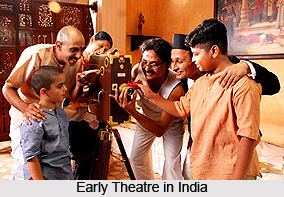 Tantupurastha Nataka Mandali of Dharwar was the first professional troupe in North Karnataka to undertake a tour in different parts of Karnataka, Maharashtra and Andhra Pradesh. It came into being early in the eighties. The troupe had among its members Bhimacharya Eri, Gopinathrao Joshi, Ramabhau Halsigi and Dattatreyarao Dharwad, who were well known for their histrionic abilities. With initial success in the villages and cities of North Karnataka, the troupe equipped itself with good costumes and settings and set out on tour to neighbouring regions for a period of two years with intermittent periods of rest. The troupe consisted of both Kannada and Marathi artists, learnt the languages of different regions and staged plays in Hindi, Marathi and Telugu. Dr. C. Narayana Rao, writing about the influence of Karnataka on the Telugu stage, recalled the visit of an enthusiastic dramatic troupe of Dharwar to Andhradesha. His observation that the troupe consisted of both Karnataka and Marathi artists suggests that the talented troupe of Dharwar was none other than the Tantupurastha Nataka Mandali.
Tantupurastha Nataka Mandali of Dharwar was the first professional troupe in North Karnataka to undertake a tour in different parts of Karnataka, Maharashtra and Andhra Pradesh. It came into being early in the eighties. The troupe had among its members Bhimacharya Eri, Gopinathrao Joshi, Ramabhau Halsigi and Dattatreyarao Dharwad, who were well known for their histrionic abilities. With initial success in the villages and cities of North Karnataka, the troupe equipped itself with good costumes and settings and set out on tour to neighbouring regions for a period of two years with intermittent periods of rest. The troupe consisted of both Kannada and Marathi artists, learnt the languages of different regions and staged plays in Hindi, Marathi and Telugu. Dr. C. Narayana Rao, writing about the influence of Karnataka on the Telugu stage, recalled the visit of an enthusiastic dramatic troupe of Dharwar to Andhradesha. His observation that the troupe consisted of both Karnataka and Marathi artists suggests that the talented troupe of Dharwar was none other than the Tantupurastha Nataka Mandali.
The troupe made a good impression on Andhra and influenced the Telugu stage, which began to emulate some of its traits. The theatre of Andhra, therefore owes a good measure of obligation to this troupe. The troupe returned to Dharwar by 1885, when the first railway lines were laid in North Karnataka. Many of the members of the troupe were tired of an itinerant life and sought employment. Quite a few of them joined the railways. This was a great loss to the North Karnataka Stage. In the last decade of the 19th century many an important professional troupe, including the one at Gadag led by Shantakavi, had become defunct, mostly due to internal feuds.
By the year 1890, there was not a single professional company sufficiently strong to hold aloft the banner of the Kannada theatre stage. Quite a number of troupes sprang up here and there it is true, but they were too feeble to do anything substantial. These troupes were crowded with enthusiastic illiterates who learnt the lines by rote and reproduced them like parrots. Drama became a ludicrous affair in the eye of the educated, and soon, the acting profession became unpopular. The effort of educated enthusiasts like Shantakavi could not restore to the stage the respect it had earlier enjoyed. The last decade of the 19th century witnessed painful convulsions of many a dramatic troupe tossing between life and death.




















